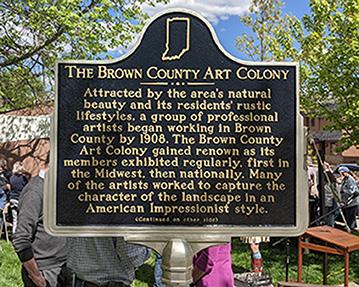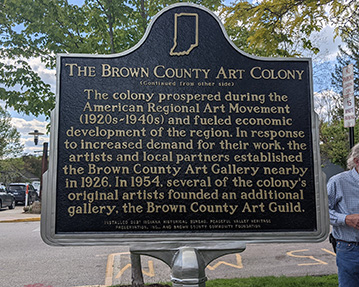

Location: The Village Green, West Main and Jefferson Streets, Nashville (Brown County), Indiana, 47448
Installed 2021 Indiana Historical Bureau, Peaceful Valley Heritage Preservation Inc., and Brown County Community Foundation
ID#: 07.2021.1
Text
Side One
Attracted by the area’s natural beauty and its residents’ rustic lifestyles, a group of professional artists began working in Brown County by 1908. The Brown County Art Colony gained renown as its members exhibited regularly, first in the Midwest, then nationally. Many of the artists worked to capture the character of the landscape in an American Impressionist style.
Side Two
The colony prospered during the American Regional Art Movement (1920s-1940s) and fueled economic development of the region. In response to increased demand for their work, the artists and local partners established the Brown County Art Gallery nearby in 1926. In 1954, several of the colony’s original artists founded an additional gallery, the Brown County Art Guild.
Annotated Text
Side One
Attracted by the area’s natural beauty and its residents’ rustic lifestyles,[1] a group of professional artists began working in Brown County by 1908.[2] The Brown County Art Colony gained renown as its members exhibited regularly, first in the Midwest, then nationally.[3] Many of the artists worked to capture the character of the landscape in an American Impressionist style.[4]
Side Two
The colony prospered during the American Regional Art Movement (1920s-1940s)[5] and fueled economic development of the region.[6] In response to increased demand for their work, the artists and local partners established the Brown County Art Gallery nearby in 1926.[7] In 1954, several of the colony’s original artists founded the Brown County Art Guild as an additional gallery.[8]
[1] William Herschell, “The Art Invasion of Peaceful Valley,” Indianapolis News, August 7, 1909, 10, Newspapers.com; William Forsyth, “Art in Indiana,” Indianapolis News, September 27, 1916, 12, accessed Hoosier State Chronicles; “Paintings of Local Artists Exhibited,” Indianapolis News reprinted (Greenfield) Hancock Democrat, December 27, 1917, 4, accessed Newspapers.com; “Brown County Pictures,” Indianapolis News, September 17, 1919, 26, accessed Hoosier State Chronicles; “Paintings by T. C. Steel on View at His Winter Studio,” Indianapolis News, December 20, 1919, 17, accessed Hoosier State Chronicles; William Herschell, “Will Vawter’s Home in Brown County,” (Greenfield) Daily Reporter, August 5, 1920, 1, accessed Newspapers.com; “Art Notes,” Indianapolis News, December 4, 1920, 5, accessed Newspapers.com; Lynn Letsinger-Miller, The Artists of Brown County (Bloomington and Indianapolis: Indiana University Press, 1994).
Some examples of paintings and prints that demonstrate the artists’ capture of the area’s natural beauty and rustic charm include: Gustave Baumann, Harden Hollow, 1912, color woodblock print, Indianapolis Museum of Art, http://collection.imamuseum.org/artwork/70620/; Louis Oscar Griffith, Brown County Cabin, n.d., ink on paper, Indianapolis Museum of Art, http://collection.imamuseum.org/artwork/73775/; Theodore Clement Steele, The Hill Country, 1913. oil on canvas, private collection, accessed Friends of T.C. Steele, https://tcsteele.org/portfolio/the-hill-country/; John William Vawter, Barnes Cabin on Owl Creek, Brown County, circa 1920, Oil on Canvas, Indianapolis Museum of Art, accessed http://collection.imamuseum.org/artwork/54304/; Theodore Clement Steele, Brown County Studio, 1921, oil on canvas, Brauer Museum of Art, Valparaiso University, accessed Friends of T.C. Steele, https://tcsteele.org/portfolio/brown-county-studio/. For more examples see Letsinger-Miller’s extensively illustrated book.
[2] Miller and Guthrie to Theodore C. Steele, Deed Record 26, Page 335, Brown County, Indiana, April, 9, 1907, Recorded April 27, 1907, submitted by applicant; “T.C. Steele to Paint in Brown County,” Indianapolis News, April 27, 1907, 14, accessed Newspapers.com; “Famous Painter Will Paint Some Scenery,” (Columbus) Republic, April 30, 1907, 4, accessed Newspapers.com; (Columbus) Republic, August 12, 1907, 8, accessed Newspapers.com; “Some of Brown County Art Products,” Indianapolis News, December 4, 1908, 11, Newspapers.com; William Herschell, “The Art Invasion of Peaceful Valley,” Indianapolis News, August 7, 1909, 10, Newspapers.com; “A Day in the Artists’ Arcadia in Brown County,” (Muncie) Star Press, September 5, 1909, 14, Newspapers.com; Adolph Robert Shulz, “The Story of the Brown County Art Colony,” Indiana Magazine of History 31:4 (December 1935): 282-289, accessed https://www.jstor.org/stable/27786760.
The prominent painter T.C. Steele purchased land in Brown County, built a home and studio, and was busy painting the surrounding landscape by the summer of 1907. See the “T.C. Steele Home, Gardens, Studio” state historical marker page for more information. After some preliminary sketching trips in 1907, the Wisconsin painter (who was also well-known in Chicago circles) Adolph Shulz arrived for an extended stay in Brown County in 1908. Shulz explained. "The year 1908 marked the first of Brown County as a famous sketching ground. That season there were about twenty-five artists painting in the County, probably at the time as strong a group of its kind as had ever gathered in a like place in the states of the Middle West."
By 1909, Indiana newspapers were providing extensive coverage of the art colony to their readers. The Indianapolis News and the Muncie Star both printed lengthy articles naming the artists in Brown County, when they began working, where they were living and working, and providing illustrations. Many of the founding artists were from Chicago, Illinois but they also came to the area from Wisconsin and other parts of Indiana. One early member was from as far as Utah.
[3] “Brown County Is Getting New Fame,” Columbus Republican, December 9, 1909, 6, Newspapers.com; “Cheerful Coloring in Indiana Artists’ Work,” Indianapolis News, March 18, 1916, 2, Newspapers.com; William Forsyth, “Art in Indiana,” Indianapolis News, September 27, 1916, 12, Newspapers.com; Lucille E. Morehouse, “Indiana Artists Display Beauties of Brown County,” September 21, 1919, 37, Newspapers.com; Mary Q. Burnet, Art and Artists of Indiana (New York: The Century Co., 1921), 209-217, 307-318, Google Books; Lucille E. Morehouse, “Brown County Art Exhibit Shows Exceptional Work,” Indianapolis Star, November 23, 1924, 16, Newspapers.com; “Art Colony Is Success,” Miami Herald, April 4, 1926, n.p., Art Colony Clipping File, Brown County Historical Society; “Art Colony Brings Brown County Fame,” Chicago Evening Post Magazine of the Art World, April 6, 1926, n.p., submitted by applicant, copy in IHB marker file; “Hoosiers Announce Picture Display,” Hammond Times, November 24, 1928, 10, Newspapers.com.
[4] “Brown County Life Awaits Interpreter,” Chicago News, June 19, 1923, n.p., Frank Hohenberger Clipping File, Indiana State Library; William H. Gerdts and Carol Lowrey, The Golden Age of American Impressionism (New York: Watson-Guptil Publications, 2003), 106; Susan G. Larkin, American Impressionism: The Beauty of Work (Greenwich, CT: Bruce Museum of Arts and Sciences, 2005), 174; Indiana Historical Bureau, William Merritt Chase, State Historical Marker 41.2010.1, https://www.in.gov/history/markers/4053.htm; Jill Weiss Simins, “Better with Age: The Late-Blooming Career of Artist Will Vawter,” Indiana History Blog, April 9, 2020, https://blog.history.in.gov/better-with-age-the-late-blooming-of-artist-will-vawter/.
Several of the Brown County artists followed the example of another Indiana-born American Impressionist, William Merritt Chase, by studying but returning to capture the unique character of the U.S. landscape and people. They returned to the U.S. with the influence of French impressionism – broad, quick strokes, a bright palette, an eye for capturing the effects of light, and a desire to paint en plein air, or outside the walls of the studio. While they drew on artistic elements from European styles as they saw fit, their goal was to create a uniquely American style of art. This style was well-fitted for capturing the oft-mentioned atmospheric and hazy quality of the light in Brown County.
[5] Indiana University, “Art Guide to Indiana from an Art Survey by the Indiana Federation of Art Clubs,” Bulletin of the Extension Division, Indiana University, 8, No. 15 (April 1931), 83-84, accessed Indiana State Library; “American Regionalism: Visions from the Heartland,” Museum of Art and Archaeology, University of Missouri, https://maa.missouri.edu/exhibit/american-regionalism; “Rise of the American Scene: Regionalism and the Dust Bowl,” Abilene, TX: The Grace Museum, https://www.thegracemuseum.org/online-learning-blog/2020/5/26/rise-of-the-american-scene-regionalism-and-the-dust-bowl; “Building the Collection: Regionalism and Folk Art,” American Paintings, 1900-1945, National Gallery of Art, https://www.nga.gov/research/online-editions/american-paintings-1900-1945/american-modernism-and-the-national-gallery-of-art/regionalism-and-folk-art.html.
In 1931, an Indiana University bulletin stated, “The Brown County Art colony is the most important group of painters in the Middle West.”
[6] “Art Colony Brings Brown County Fame,” Chicago Evening Post Magazine of the Art World, April 6, 1926, n.p., submitted by applicant, copy in IHB marker file; “One Thousand Visit New Art Gallery,” Brown County Democrat, October 14, 1926, Newspapers.com; “Art Gallery Association Grows Rapidly,” Brown County Democrat, September 16, 1926, 1, Newspapes.com; “Brown County Teems with Activities Intended to Aid Motorists in Enjoying the ‘Hilly Playground,’” (Columbus) Republic, October 2, 1928, 3, Newspapers.com; “Variety and Number of Attractions Credited Secret of Brown County’s National Appeal,” Indianapolis Star, October 29, 1939, 8, submitted by applicant, copy in IHB file; Shulz, 288; Letsinger-Miller, 12-13.
The fame of the art colony spread along with the attraction of the new art gallery in 1926 brought tourists both to see the paintings and the local landscape that inspired them. After the gallery opened in 1926, the Brown County Democrat reported: “Each day brings many new visitors, and the fame of Brown county as a place of beauty is growing.” The Brown County Democrat estimated one thousand people visited the gallery’s first exhibit in 1926. This increased tourism led to locals opening more shops, restaurants, and hotels to accommodate the tourists, while city-based Hoosiers bought nearby vacation homes, stimulating the local economy. In 1934 alone over 9,000 people visited the Brown County Art Gallery, according to Shulz.
[7] “Brown County Art Gallery at Nashville,” Brown County Democrat, September 2, 1926, 1, Newspapers.com; “New Art Gallery,” Huntington Herald, September 8, 1926, 8, Newspapers.com; “Artists in Brown County Organize,” Indianapolis Star, September 8, 1926, 1, Newspapers.com; “Painting Exhibit in Brown County Opened to Public,” Indianapolis Star, October 10, 1926, 22, Newspapers.com; Frank M. Hohenberger, Brown County Art Gallery, Exterior, 1926, photograph, 8 x 10 in., Frank M. Hohenberger Photograph Collection, Indiana University Libraries, http://purl.dlib.indiana.edu/iudl/lilly/hohenberger/Hoh009.000.0568; “Incorporations,” Indianapolis Star, July 13, 1927, 18, Newspapers.com; Brown County Art Gallery Association, From the Gallery of the Brown County Art Association, circa 1928, pamphlet, Indiana State Library; Frank M. Hohenberger, Jake Kennedy Painting Art Gallery, 1929, photograph, 4 x 5 in., Frank M. Hohenberger Photograph Collection, Indiana University Libraries, http://purl.dlib.indiana.edu/iudl/lilly/hohenberger/Hoh004.010.0024; Indiana University, “Art Guide to Indiana from an Art Survey by the Indiana Federation of Art Clubs,” Bulletin of the Extension Division, Indiana University, 8, No. 15 (April 1931), 83-84, accessed Indiana State Library; Frank M. Hohenberger, “Brown County Artists Open Annual Exhibition in New Gallery at Nashville,” Indianapolis Star, April 14, 1935; Shulz, 287-88.
In 1926, the artists formed the Brown County Art Gallery Association to exhibit and sell paintings. Local hotel owner William Wilkes remodeled a store building on Main Street to include an art gallery and art supply store and served as gallery manager. In 1935, the gallery had become so popular that the association expanded into the rest of the building, doubling the size of the space. The Hohenberger photographs show the original gallery and sign. For examples of work of the Brown County Artists at this time see Letsinger-Miller.
[8] “Art Guild Organized,” Brown County Democrat,” August 5, 1954, 1, Newspapers.com; “New Art Group Opens Gallery in Nashville,” Franklin Evening Star, August 17, 1954, 1, Newspapers.com; “Artists Feudin’ and Fussin’ in Brown County,” Indianapolis News, November 17, 1954, 1, Newspapers.com; Brown County Art Guild, “The Real Story About the Brown County Art Galleries,” ca. 1954-1955, clipping file, Indiana State Library.
Many of the original Brown County art colony artists split from the Association to form the Brown County Art Guild in 1954. The Guild allowed only professional artists while the Association had begun allowing amateur artists. The Guild established their gallery in the Old Minor House on Shoppers Lane.
